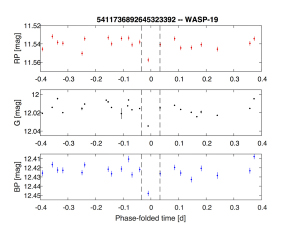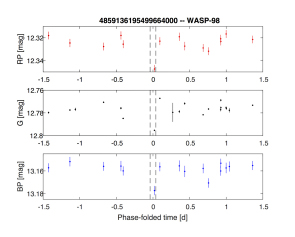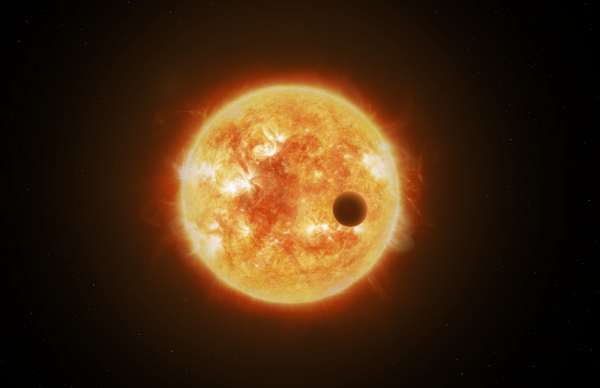Exoplanets
The study of planets around stars beyond the Sun is a recent topic in astronomy, with the first discoveries dating back to the late 1980s and early 1990s. There is now solid evidence for a few thousand planetary systems, several hundred of which host more than one planet [1].
Due to the vast number of stars that are being surveyed by Gaia over the entire sky, the mission has the potential to discover many thousands of new exoplanets within a few thousand light-years of the Sun, via astrometric as well as photometric measurements [2].
Finding the wobble - detecting exoplanets with astrometric measurements
Using repeated measurements over a period of time for each of the more than one billion stars observed by Gaia, scientists can determine five parameters: the two-dimensional position of the star on the plane of the sky at a reference time, the two-dimensional proper motion (the projection on the sky of the star's true motion through the Galaxy) and the parallax (the annual shift of the star's apparent position due to Earth's motion around the Sun).
| Star and planet orbiting their common centre of mass. Credit: ESA. Click here for video details |
The presence of one or more objects (other stars or planets) orbiting a star perturbs its motion, and this perturbation is reflected in the positions, which do not quite match a pure stellar motion described with parallax and proper motion.
So far, less than a handful of exoplanets have been discovered using this astrometric technique with ground-based observations, while astrometric information provided by ESA's Hipparcos mission (the predecessor of Gaia), the NASA/ESA Hubble Space Telescope, and large ground-based telescopes have been used to refine the orbit determination of planetary systems that had been discovered with the radial velocity method.
With an anticipated astrometric precision around 10 microarcseconds [3] for the brightest stars [4], scientists forecast that it will be possible to detect some tens of thousands of exoplanets out to 500 parsec (around 1600 light-years) from the Sun by measuring the wobble they cause in the path followed by their parent stars on the sky [5].
| Detecting exoplanets with astrometry. Credit: ESA. Click here for video details |
Based on current estimates of the distribution of planets and their orbits, roughly 1000–1500 of these discoveries are expected to be planets orbiting M-type dwarf stars within a distance of 100 parsec (about 320 light-years) from us. These red stars are cooler, smaller and less massive than the Sun (with masses ranging between 0.075 and 0.50 solar masses) and represent the most abundant stellar population in our Galaxy.
M-type dwarf stars are especially interesting for exoplanet searches because there are many and they have low mass – the latter meaning that they are subject to larger wobbles than their more massive counterparts orbited by a planet of a given mass. In addition, due to their low surface temperatures, M-type dwarfs host potentially habitable planets at much closer distances than hotter and more massive stars.
The astrometric technique can be used to detect planets with periods ranging from several days to several years. An important aspect of this technique is that it allows scientists to measure the mass of the planet, unlike the radial velocity technique that only provides a lower limit to the mass.
Detecting the dip – using photometry to discover transiting exoplanets
If the orbit of an exoplanet is aligned in such a way that the planet crosses the disc of its parent star as seen from Earth, then it is possible to detect the presence of the planet in terms of a periodic decrease in the star's brightness.
| Detecting exoplanets with the transit method. Credit: ESA. Click here for video details |
To detect an exoplanet using this 'transit' method, observations must be performed while the planet is moving across the disc of the parent star. This transit only happens over a small fraction of the planet's total orbit. Since transits are more frequent for short-period planets, this technique is best suited to detect planets with orbital periods between one and a few days.
Surveys to search for transiting exoplanets are usually designed so that the observations of the parent stars are frequent – to catch as many transits as possible. The way that Gaia surveys the sky means that it will observe each star an average of 70 times during the five years of the nominal mission but when and how often the observations are made will be determined by the scanning law and cannot be changed. However, if a star is orbited by a transiting planet, then a few observations acquired by the satellite during transits might be sufficient to obtain a detection.
Scientists predict that, with the precision of Gaia's photometric measurements [6], it will be possible to discover a few hundred to a few thousand transiting, massive planets of the hot Jupiter and very hot Jupiter types. These are gaseous giant planets, about the mass of Jupiter, that orbit their parent star at very short distances, much smaller than the distance of Mercury from the Sun, completing one orbit on time scales of a few days.
As a test, a team of scientists from the Gaia Data Processing and Analysis Consortium has looked at one year's worth of data from the satellite for two stars that are known to host transiting exoplanets. From 24 Gaia observations of WASP-19b and 20 Gaia observations of WASP-98b, they found one observation for each star that happened to be during a transit. This preliminary result has given scientists the confidence that detecting transiting exoplanets with Gaia may be feasible.
 |
 |
| Gaia folded light curve of WASP-19b. Credit: ESA/Gaia/DPAC/CU7 |
Gaia folded light curve of WASP-98b. Credit: ESA/Gaia/DPAC/CU7 |
In addition, it is likely that a few dozen of the exoplanets detected using Gaia astrometric measurements will happen to be transiting planets with periods of two to three years, which would not have been detected via the transit method because of their long periods. Once these planets are identified, however, it will be possible to observe them during a transit (or to search for a possible transit that was already recorded in the Gaia photometry) and extract additional information such as the orbital configuration of the system.
Applications
With a large sample, potentially tens of thousands, of newly detected exoplanets, Gaia will allow scientists to perform statistical studies of the properties and frequency of planets as a function of the characteristics of the parent star. This in turn will allow them to learn more about the formation and evolution of different types of planets and planetary systems, helping to put our own Solar System in a broader context.
Notes
[1] As of 2 February 2017, the Exoplanet Team's website (exoplanet.eu) lists 3576 confirmed planets in 2686 systems (including 602 multiple systems), NASA's exoplanets archive (exoplanetarchive.ipac.caltech.edu) lists 3447 confirmed planets (along with almost 4700 Kepler transit candidates), and the Exoplanet Data Explorer (exoplanets.org) lists 2950 confirmed (of which 2925 have a robust orbit determination).
[2] It is not expected that Gaia will detect exoplanets using the radial velocity technique, which is based on searching for periodic shifts of absorption lines in the spectra of stars. These are caused by the wobble of the star arising from one or more planets in orbit. Even though there is a Radial Velocity Spectrometer on Gaia, this instrument will not reach the sensitivity needed to detect exoplanets. However, the measurements by Gaia will be very useful in identifying false alarms because the accuracy is sufficient to clarify that some candidates are double stars rather than stars with an orbiting planet.
[3] Minutes, or seconds, of arc are used to describe very small angles. An arcminute is one sixtieth of a degree and an arcsecond is one sixtieth of an arcminute. A microarcsecond, which is one millionth of an arcsecond, is equivalent to the edge of a euro coin on the Moon as seen from Earth.
[4] The 10 microarcseconds precision expected for the brightest stars in the final Gaia catalogue will be based on cumulative data from the five-year nominal mission; the precision of individual measurements will be around 60 microarcseconds for the brightest stars.
[5] Current estimates, from Perryman et al. 2014, suggest that 21 000 (±6000) exoplanets out to 500 parsec (around 1600 light-years) will be detected using astrometric measurements from Gaia's five-year nominal mission.
[6] The expected error on Gaia's photometric measurements is about 1–10 millimagnitudes.








